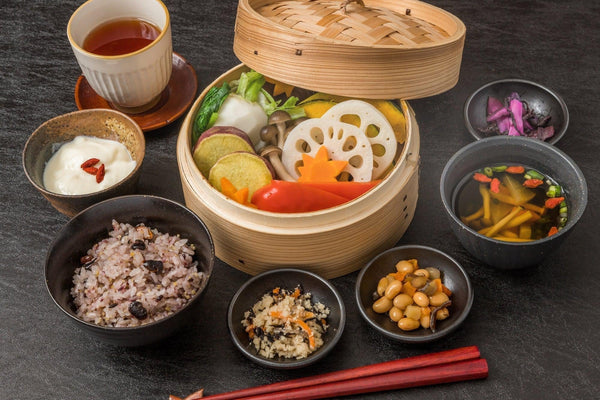
Jump to:
Meat is a prominent part of the Japanese diet today, with an average consumption of approximately 4.7 ounces (130 g) per person. But did you know that meat has only been eaten widely in Japan for about one and a half centuries?
The two main religions in Japan, Shintoism and Buddhism, both advocate largely plant-based diets. Shojin Ryori, which we look at in this article, is a way of eating developed by Buddhist monks that has a loyal band of followers beyond the temple boundaries.
In this article, we will look at the history, core principles, and ingredients of Shojin Ryori, reasons for the recent interest in this traditional Buddhist cuisine, its suitability for vegans, and where you can go to try it out in Japan.
What Is Shojin Ryori?

The name “Shojin Ryori” is made up of the two words of “Shojin”, a term used in Buddhism that refers to devotion in pursuit of enlightenment, and “Ryori”, which refers to cooking.
While it is tempting to classify Shojin Ryori as simply Japanese vegetarian food, this is an oversimplification and can also be misleading.
It is true that no meat or fish is used, and Shojin Ryori makes copious use of soy-based products, wheat gluten, and seasonal vegetables. However, in its purest form, it even disqualifies the use of some foods that would normally be enjoyed by both vegans and vegetarians. For example, there is special treatment of the “Gokun” family of root vegetables, including leek, chives, onion, and garlic. Whereas in the modern age, people may refrain from these in some circumstances due to the antisocial nature of the way they linger on the breath, in Buddhist tradition, their pungent smell was considered to promote lust when cooked and anger when eaten raw, and so are not used in Shojin Ryori.
In addition to simply abstaining from animal products, Shojin Ryori includes several core principles that are followed in the choice of ingredients and preparation and serving of the food. In this sense, Shojin Ryori is more of a way of life than a diet.
Origins Of Shojin Ryori

It was not until 1872, when the Meiji Emperor was seen eating beef in public, that the eating of meat started to become widespread in Japan. This was widely seen as the royal family giving its stamp of approval to a trend that had begun when Perry’s black ships entered Tokyo Bay, bringing in regular trade and discourse with the West, and effectively ending Japan’s 200-year period of isolation.
One reason for the lack of meat eaten in Japan was agricultural, with the lack of arable land causing farmers to prioritize the more productive use of land for plant production.
Another reason was the spread of Zen Buddhism in the 13th Century. One of the central tenets of Buddhism is the avoidance of the unnecessary killing and harming of animals. It is said that Dogen Zenji, considered the founder of Zen Buddhism, introduced Shojin Ryori, a sophisticated form of vegetarian cuisine, from China around this time. This incorporated the idea that “preparing meals is also a role of monks in a community life and is done as training.”
Core Principles Of Shojin Ryori

The number “five” is very important in Buddhism and Shojin Ryori embodies this in that it prescribes that Shojin Ryori should contain five colors (red, yellow, green, black, and white), five flavors (sweet, sour, salty, bitter, and umami), five methods of preparation (raw, stewed, boiled, roasted, and steamed), and five elements (theory of “Godai”, where different legumes, fruits, and vegetables provide different benefits). It is believed that the combination of these “fives” provides nutritional balance, as well as providing balance for the body with each season.
As mentioned above, Shojin Ryori emphasizes the importance of being in harmony with nature by eating the produce of the season. This includes cooling vegetables such as cucumber in the summer, sweet potatoes in the autumn, the hearty root vegetables used in winter soups, and flowering vegetables in spring. Tofu, used to provide protein, is used the whole year round. Dewa Sanzan Shoji Ryori, a representative variety found in the temples of Kyoto and Koyasan in Wakayama Prefecture, for example, makes extensive use of “sansai” (mountain vegetables), the types of which differ according to the season. You can read more information about sansai in our sansai article.
When monks eat Shojin Ryori at a temple, they follow an elaborate ritual, that involves sitting on the floor, clapping two wooden sticks, called ”Hyoshigi,” together, and reciting sutras at a fast pace. The monks serve themselves rice and Japanese pickles, and when they finish eating as much of the rice as they can scrape off with their chopsticks, hot water is poured into the bowl and a piece of pickled radish is used to clean the remaining grains of rice from the bowl and eat them.
Of course, you don’t need to go through this ritual to enjoy Shojin Ryori, but this last aspect is very instructive about one of the key concepts of Shojin Ryori, in that one should aim to absolutely minimize waste. In the same way that the monks hoover up every last grain of rice and make sure it is consumed, Shojin Ryori chefs will use the peel of carrots and radishes, as well as the vegetable tops from one meal, to make the broth of the next meal, and cuttings can be added to rice dishes. This is so they waste as little of the ingredients as possible. In essence, it is a highly sustainable way of eating.
Signature Shojin Ryori Dishes
So, what are the signature Shojin Ryori dishes? Let's take a look at some common and tasty Shojin Ryori dishes below.
Hokka Hokka Kenchinjiru

Hokka Hokka Kenchinjiru uses Shojin dashi (broth base) made of shiitake mushrooms and konbu kelp and this provides umami to the soup containing hearty root vegetables, such as carrots and “Gobo” burdock root that warm the cockles during winter.
Light O-den

Another popular Shojin Ryori winter dish is Light O-den. It is referred to as Light O-den because O-den commonly eaten in Japanese homes during winter contains boiled eggs and “hanpen” fish paste. As animal products are traditionally eschewed in Shojin Ryori, these are not included, but the richness of the broth makes this a delicious warming dish in winter, with vegetables and kelp alone.
Goma-dofu

Goma-dofu is a dish that can be eaten the whole year round. Goma (sesame) paste is placed on top of tofu with wasabi (Japanese horseradish). In the summer, this is likely to be served with cucumber in Summer, or Fuki (butterbur) in Spring.
Is Shojin Ryori Vegan-Friendly?
Although traditionally, Shojin Ryori would be considered completely vegan-friendly, some modern-day monks will use dairy products in their dishes as they do not consider them to be harmful to animals.
If your diet completely prohibits animal products, you should also find out what the “dashi” or base for the broth is that is used when preparing the dishes. The original “Shojin dashi” gets its umami from kelp and shiitake mushrooms and is completely vegetarian- and vegan-friendly. However, it has been reported that some restaurants and even some temples use dried bonito flakes as the base for the broth.
It is even possible that some restaurants advertised as “Shojin Ryori” may serve “meat-takes” on Shojin Ryori. The bottom line is that if you are a strict vegan or even a vegetarian, it would be wise to check in advance what you are getting before you order.
Where To Eat Shojin Ryori

There is a wide range of options available for you if you would like to try Shojin Ryori. Due to its deep roots in Buddhism, it may be worth making the effort to eat it at a temple in order to enjoy the full experience. You cannot just turn up at your local temple and expect to be fed, however, as not all temples are willing to serve the general public.
If you do a little research in advance, however, you will be able to find many Shojin Ryori restaurants where you will be served by monks, within temples in many locations throughout Japan, including some Michelin-rated fare in Kyoto.
It is even possible to go one step further and stay overnight at a “Shukubo” lodging in a Buddhist temple. The word “Shukubo” literally means “sleeping with the monks”. These are predominantly places for monks to stay and are generally considered comfortable (although don’t expect high-speed Internet). In addition to enjoying Shojin Ryori in an authentic environment, you may even get given cooking lessons.
You can enjoy Shojin Ryori without going to temples and many restaurants in Tokyo and other major Japanese cities serve Shojin Ryori. As previously mentioned, however, some restaurants will tend to stretch the definition of Shojin Ryori and include animal products in the broth or other parts of the meal, so ask ahead if you have strict dietary requirements.
If you can't make it to Japan to try Shojin Ryori soon, you can of course replicate shojin ryori dishes at home too! If you're looking for traditional shojin ryori ingredients like shiitake mushrooms, dried kombu, vegetables, or more, be sure to check out our selection at Japanese Taste.
Shojin Ryori – Has Its Time Come?
The clamor to eat meat in Japan around the time of the Meiji Restoration was due, in part, to a view of meat-eating Westerners as being powerful and that this was something to be emulated. The mood of the age was one of celebrating the possibilities of globalization.
It could be argued that the emphasis in the current age is one of limiting the burden that each of us has on the environment. Shojin Ryori, by using the foods we have around us that are currently in season, rather than using energy to transport them from far-off countries, reduces the carbon footprint involved in eating. Its emphasis on minimizing waste makes it a perfect food for the age in which we are living.
Shojin Ryori aims to bring out the natural taste of the food it uses rather than overpower it with heavy seasonings or sauces. This does not mean that the food lacks flavor by any means, and there is plenty for the vegan, vegetarian, and, of course, the omnivore to enjoy with Shojin Ryori.
Have you tried Shojin Ryori yet? If so, let us know what you think of it in the comments.


0 comments